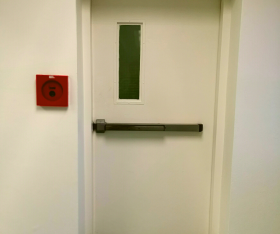Fire Emergency Evacuation Plan (FEEP) & Fire Procedure

What is a Fire Emergency Evacuation Plan (FEEP)?
A fire emergency evacuation plan (FEEP) is a prepared written document which includes the action to be taken by all employees in the event of fire and the plans set in place for calling the fire brigade. It can include any relevant information in relation to the FEEP.
For small business premises, a FEEP could take the form of a simple fire sign, posted in places where everyone in the building, including all staff and visitors, can read it and understand how to take action in the event of a fire.
Larger business premises will require a more detailed emergency action plan, which will be borne from a detailed fire risk assessment , and which should be prominently displayed at all times.
How to prepare an emergency evacuation plan
Consider how you will arrange the evacuation of the premises in the light of your fire risk assessment, and the additional fire precautions you have, or intend to have in place.
Your Emergency Plan should be appropriate to your premises and could include:
-
How people will be warned if there is a fire
-
What staff/wardens should do if they discover a fire
-
What guests/visitors should do if they discover a fire
-
How the evacuation of the premises should be carried out
-
Where people should assemble after they have left the premises and procedures for checking whether the premises have been evacuated
-
Identification of key escape routes, how people can gain access to them and escape from them to a place of total safety
-
Arrangements for fighting fire
-
The duties and identity of staff who have specific responsibilities if there is a fire
-
Arrangements for the safe evacuation of people identified as being especially at risk, such as those with disabilities, children, and lone workers
-
Any machines/appliances/power supplies that need to be stopped or isolated if there is a fire
-
Specific arrangements, if necessary, for high-fire-risk areas
-
Contingency plans (e.g. restrictions on the use of the building) for when life safety systems such as evacuation lifts, fire detection and warning systems, sprinklers or smoke control systems are out of order
-
How the Fire and Rescue Service and any other necessary services will be called and who will be responsible for doing this
-
Procedures for meeting the Fire and Rescue Service on their arrival and notifying them of any special risks, e.g. the location of highly flammable materials; and liaison between building owners, employers, managing agents, other occupiers, residents and the Fire and Rescue Service
Identification of key escape routes
Key escape routes should be easily identifiable to all persons unfamiliar with the layout of your premises. They could include schematic drawings and most importantly exit and route signs.
The role of Fire Wardens/Marshals in a Fire Emergency Evacuation Plan
Staff
expected to undertake the role of Fire Wardens would require more comprehensive
training. Their role may include:

-
Helping those on the premises to leave
-
Checking the premises to ensure everyone has left
-
Using firefighting equipment if safe to do so
-
Liaising with the fire and rescue service on arrival
-
Shutting down vital or dangerous equipment; and
-
Performing a supervisory/managing role in any fire situation.
Training for this role may include:
-
Detailed knowledge of the fire safety strategy of the premises
-
Awareness of human behaviour in fires
-
How to encourage others to use the most appropriate escape route
-
How to search safely and recognise areas that are unsafe to enter
-
The difficulties that some people, particularly if disabled, may have in escaping and any special evacuation arrangements that have been pre-planned
-
Additional training in the use of firefighting equipment
-
An understanding of the purpose of any fixed firefighting equipment such as sprinklers; and Reporting of faults, incidents and near misses.
-
Reporting of faults, incidents and near misses
The number of fire wardens depends on the size and complexity of the premises.
Fire wardens should be competent in the use of fire extinguishers, should have some knowledge of fire prevention and be able to identify possible fire hazards to prevent fire from occurring. Finally, they should have an in depth knowledge of the FEEP and their role in implementing it.
What are the steps of fire evacuation procedure?
-
Adhere to the fire evacuation strategy
-
Take the relevant action on hearing the fire alarm
-
Take the appropriate action on discovering a fire
-
Calling the fire brigade
-
Power/process isolation
-
Identification of key escape routes
-
Notify fire marshals/wardens
-
Assemble at the arranged fire assembly place and take a roll call
"ISE Fire have been looking after the maintenance of our fire alarm system as well as our fire extinguishers for a number of years. I have found the team very professional and efficient. In a Hotel environment, an urgent response is extremely important and ISE Fire have always been very quick to deal with emergency calls. I have no hesitation in recommending ISE Fire."
Valerie Hazelton, Owner of Rushton Hall Hotel and Spa

Can I get a free business survey to assess my fire risk?
You certainly can.
At ISE, we are committed to customer satisfaction and happiness.
We therefore offer a free visit to survey your business premises, and advice given on fire safety equipment, bespoke to your business needs. We don’t believe in pushy sales, as we prefer to build long term relationships with our clients, and will always offer competitive quotes.
If you have questions about fire safety in the workplace, get in touch with us today. Fill in the quick online form to discuss your Fire Safety needs today!
Index